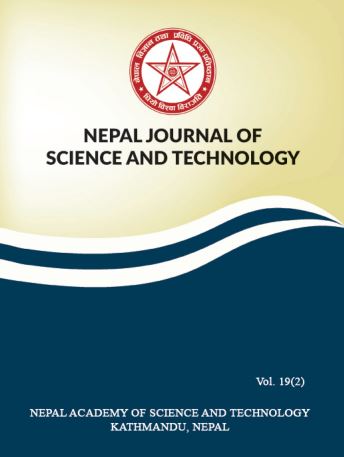Bacterial Assessment of Buffalo Meat in Kathmandu Valley
DOI:
https://doi.org/10.3126/njst.v20i1.39438Keywords:
Buff meat, gram-negative bacteria, ASTAbstract
Meat is highly nutritious and mostly consumed food. Usually, meat gets contaminated because of improper handling, open transportation practice, unhygienic cutting tools, and can cause various food–borne illnesses. This study was focused to determine bacterial load and occurrences of potential pathogenic bacteria in the raw buffalo meat sold in Kathmandu valley. Altogether 40 raw buffalo meat samples were collected and assessed. In addition, antibiotic susceptibility of gram-negative bacterial isolates was tested. The total plate count (TPC), and coliform count (CC) in the samples were found comparatively highest from the Asan area of Kathmandu with 9.6±0.02 log CFU/gm and 8.9±0.00 log CFU/gm respectively. Altogether 10 genera of gram-negative bacteria were identified based on the various biochemical tests. The isolated gram-negative bacteria included Proteus spp (39%, 21/54), Pseudomonas (19%, 10/54) Citrobacter spp. (9%, 5/54), E. coli (7%, 4/54), Serratia marcescens (5%, 3/54), Salmonella spp. (9%, 5/54), Enterobacter spp. (2%,1/54), Morganella morganeii (2%,1/54), Klebsiella (2%, 1/54), Yersinia enterocolitica (6%,3/54). The antibiotic susceptibility tests for the isolates was carried against six different antibiotics including-Ofloxacin (OF), Ciprofloxacin (CIP), Nalidixic Acid (NA), Nitrofurantoin (NIT 300), Amoxycillin (AMX) and Chloramphenicol (C). Out of total 54 isolates, 36 were found to be multidrug- resistant. The results of this study clearly revealed buffalo meat sold in Kathmandu valley was contaminated with potential bacterial pathogens which may cause various food- borne illnesses. The occurrence of multi - drug resistant bacteria in the meat samples is alarming threat to public health. Adequate measures to protect bacterial contamination in buffalo meat is highly recommended.
Downloads
Downloads
Published
How to Cite
Issue
Section
License
Copyright (c) 2021 Barsha Koirala, Radha Bhattarai, Rashmi Maharjan, Sanjeet Maharjan, Shova Shrestha

This work is licensed under a Creative Commons Attribution-NonCommercial 4.0 International License.
Authors retain copyright and grant the journal right of first publication.




